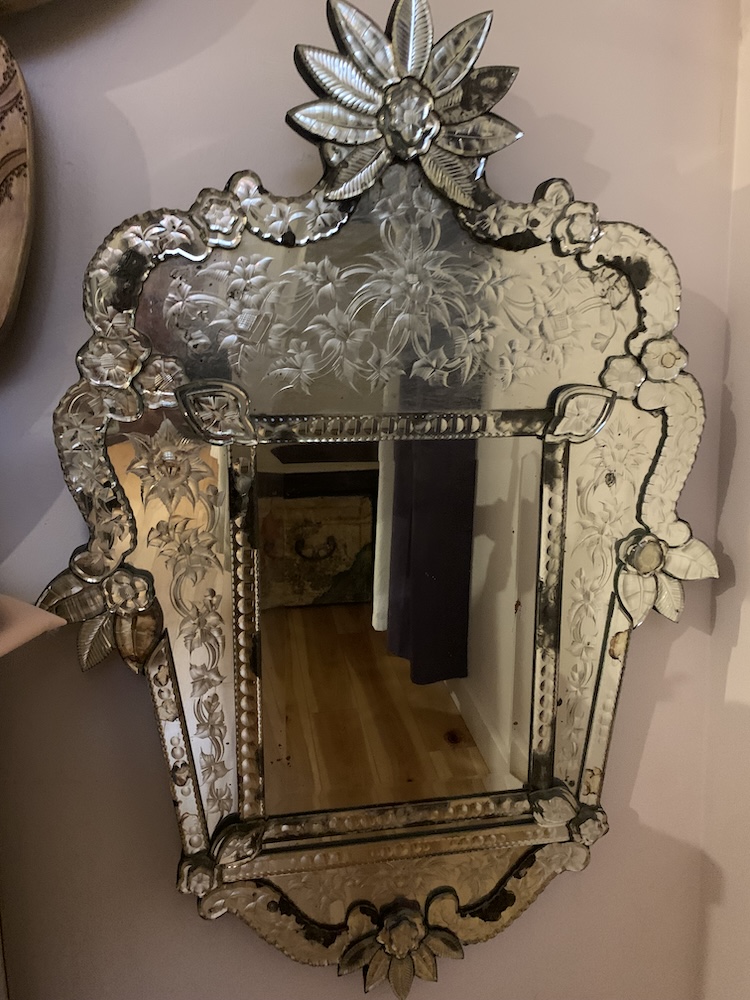Venetian Glass Mirror

You know what you look like every morning because you have a bathroom mirror. But until the 15th century no European had a glass mirror, and if you wanted to see yourself, one looked into a lake, or a piece of bronze. When did wall mounted glass mirrors come into existence? HH, who has a lovely 17th century-style Venetian glass mirror – etched and mounted on wood – wants to know when highly decorated mirrors entered the history of the looking glass.
The story begins in Venice, the Floating City; or more traditionally La Serenissima. The city is known for its most famous product, glass – as diaphanous as water, and just as difficult to mold. Glass, like water, is a liquid.
In the 15th century, the island of Murano rose to prominence as the world’s greatest glass making center, named the “Isle of Glass.” The first recorded mirror was made there in 1369. Few people could afford a glass mirror, because of the difficulty in their manufacture. A looking glass owned by a nobleman from the 14th to the 17th century was a prized possession and often listed in their estate inventory upon death. Mirrors were often willed to heirs.
The process of making a silvered glass mirror was laborious and dangerous. Glass and a silver alloy were fused, and mercury, a toxic substance, was used to do the fusing. In 1540, Vincenzo Redor patented a process for the levelling and polishing of a rolled glass sheet, producing for the first time a uniformly shaped mirrored glass. In the mid-15th century Angelo Barovier added lead to the glass compound, and created Cristallo glass, which was transparent, colorless, and imitated rock crystal. In 1546 the Venice Mirror Guild was founded, and by the year 1600 mirrors were fashionable and therefore exported to the great Courts of Europe, purchased in small rectangles of mirrored silver glass in a simple wooden frame.
Various techniques in manufacturing were used to make this new and precious commodity: the process was called the flat mirror technique in which glaziers melted tin in glass tubs and applied when very hot to the flat glass. They would polish the tin to make it reflective and, adding gold and bronze to the mixture, followed by rubbing the reflective surface of the glass mirror with iron oxide powder to make it shiny and transparent. Another technique, invented later, involved quicksilver. Sheets of tin were pounded and spread, then rubbed with quicksilver with chamois rags. Once this was done, both the tin which had been rubbed with quicksilver and the flat glass where hot-pressured together. Any bubbles formed in this process rendered the mirror unusable.
The glass, since it was hand rolled, did not always offer the gazer a true reflection of him or herself. However, mirrors were not just vanity pieces, but were used to cast light around a room: a candle in front of a mirror becomes exponential in lighting power. Louis XIV’s hundreds of mirrors purchased at great expense for the ballroom at Versailles is a good example.
Venice was known for the perfection of glass blowing because of Byzantine craftsmen that worked in Venice as early as the 5th and 6th centuries. Venice was settled by people of the East; other peoples with a strong glass tradition came as well, such as Syrians and Egyptians, the original master glass makers. Venice became a refuge for many people of many cultures, because in the 5th and 6th centuries Rome was crumbling. Barbarian hordes invaded the once-cultured city and Romans were among those fleeing. The area that was known as Venice was marshland, not desired real estate and difficult to conquer. Wise people of many parts of the Mediterranean world found that a town built upon marches and water was impenetrable by the Barbarian hoards. No castles with moats were necessary in Venice.
HH’s mirror is in the Rococo style, an important signature of 17th and 18th century Venetian art. The first such mirrors, with elaborate shapes and etched glass carvings, were a tour de force of the glassmaker’s art: those rounded shapes were cut by hand. The early ancestor of HH’s Venetian glass mirror is from the early 17th century when the style for curvilinear shapes in furniture and decorative arts replaced the previous, more linear style. HH’s mirror is a 19th century reproduction of a 17th century Venetian mirror; the 19th century collector of fine Venetian glass mirrors would commission a larger copy of a 17th or 18th century mirror. The value of HH’s mirror is $1,800.







You must be logged in to post a comment.